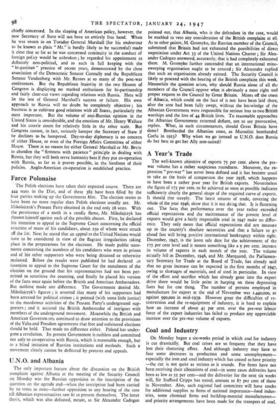Coal and Industry
On Monday began a six-weeks period in which coal for industry is cut drastically. But coal crises are so frequent that they have lost their shattering effect. And although industry may have to face some decreases in production and some unemployment— especially the iron and steel industry which has ceased to have priority —the cut is not quite as serious as it sounds. For firms have not been receiving their allocations of coal—in some cases deliveries have been as low as 55 per cent—and the deliveries for the next six weeks will, Sir Stafford Cripps has stated, amount to 87 per cent of those in November. Also, each regional fuel committee will have stocks for additional supplies to firms of national importance—food indus- tries, some chemical firms and building-material manufacturers— and priority arrangements have been made for the transport of coal.
It is on the whole better to have small certain supplies than unfulfilled promises. Meanwhile the coal industry ,generally has some gleams of light to- show, though they are offset with a good deal of darkness. Production for 1946 was 6,527,300 tons higher than -for 1945 ; but consumption has increased even more. The quality of the labour force has improved, and output has gone up by 4 per cent a manshift ; but the raising of the school-leaving age next April will reduce still further the number of young recruits. Last week the National Union of Mineworkers at last agreed to the employment of Polish ex-Servicemen ; but at the moment only about 170 ex-miners are available—though there is a potential pool of thousands of young Poles. In any case coal is a very long-term problem, and the Government's six-weeks plan will by no means see ihe end of it.



































 Previous page
Previous page